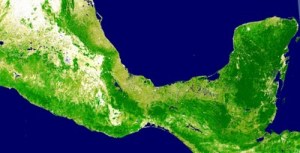
A forest cover and water map of Mexico (southern portion, including the Yucatan peninsula), produced in collaboration with scientist Matthew Hansen and CONAFOR. Credit: Google.org
The more I write about environmental issues, the more I like writing about technology. Maybe that’s because while reporting on the decline of the environment can be, frankly, depressing (the naturalist Lois Crisler once remarked of the inextricable link between “love [of the earth] and despair”), while technology is undeniably optimistic, one new and better product rolling off the line after the last.
More and more, however, I find the two areas—the environment and technology—overlapping. That’s obvious in fields like renewable energy, where scientists in government labs and private start-ups are searching for the next great way to create clean and abundant power. But computers and the Internet are now providing better ways to understand the environment around us—and ultimately protect it. The Google Earth app—besides allowing us to spy on our childhood home—lets us see our planet as only the astronauts have ever seen it. And when the oceanographer Sylvia Earle noted that something was missing from Google Earth—namely, the water—the company added the ability to look into the oceans and seas on our watery world.
Now Google is taking its Earth app a step forward. At the U.N. climate summit in Cancun this morning, the company’s philanthropic arm Google.org launched the Google Earth Engine, a new technology platform that will enable global monitoring of change in the planet’s environment. Google has tapped a quarter-century of satellite images provided by Landsat, which includes most of the developing world, along with data including MODIS, a major weather tracking project. As the project’s chief engineer Rebecca Moore told Juliet Elperin of the Washington Post, the Earth Engine provides “a living, breathing model of the earth with all of the data and analysis that’s available.”
It’s that last part that’s particularly important. The data Earth Engine will tap isn’t new, but Google will make it far more accessible and far more searchable than it has ever before. That will be a major boon for environmental researchers, for whom data is lifeblood. And it’s particularly important for projects on forestry and on preventing deforestation.
As part of the announcement, Google will also be giving away 20 million CPU hours free to the developing world and to scientists in order to help them make use of the tool. One of the biggest barriers to the effective implementation of avoided deforestation or REDD (which allows tropical countries to receive payments in exchange for keeping their forests standing) has always been the lack of on the ground data. If researchers can’t track the rate of deforestation in a country like, say, Bolivia over time, it’s impossible to design an effective scheme for REDD that will be both fair for the people and good for the climate. Google Earth Engine could make a difference, both for the climate—deforestation is responsible for 12-18% of annual greenhouse gas emissions—and for sustainable development.
The project is already beginning to bear fruit—together with Matt Hansen of the Geographic Information Science Center at South Dakota State University and Mexico’s National Forestry Commission, Google has built the finest-scale forest and water-map of Mexico ever made. (The map needed 15,000 hours of computation, but Google Earth Engine completed the task in less than a day, using 1,000 computers over more than 53,000 Landsat scenes, plus data from the Mexican government.)
Of course, a nice app from Google doesn’t change the basic economic factors that drive deforestation in poor tropical countries, nor does it help break the gridlock holding up international negotiations in Cancun. But forestry is one of the few bright spots in environmentalism right now—deforestation in the Brazilian Amazon has dropped to a record low—and technology could make it brighter.


